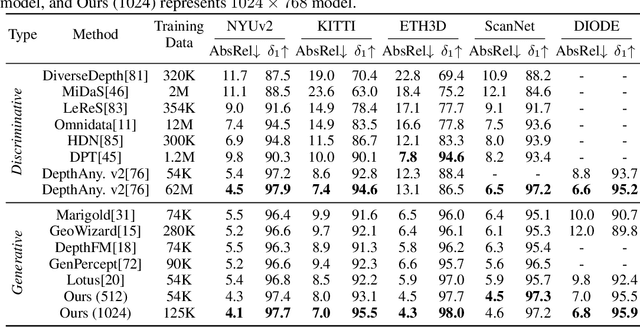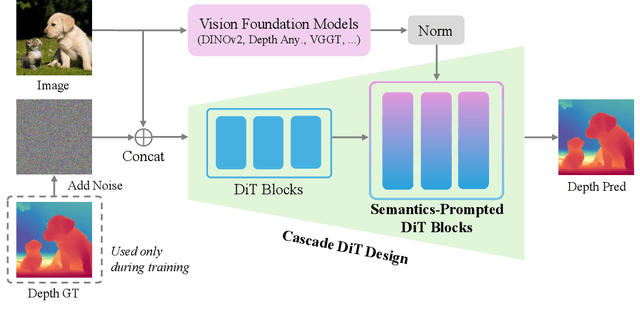Haotong Lin
Pixel-Perfect Depth with Semantics-Prompted Diffusion Transformers
Oct 08, 2025



Abstract:This paper presents Pixel-Perfect Depth, a monocular depth estimation model based on pixel-space diffusion generation that produces high-quality, flying-pixel-free point clouds from estimated depth maps. Current generative depth estimation models fine-tune Stable Diffusion and achieve impressive performance. However, they require a VAE to compress depth maps into latent space, which inevitably introduces \textit{flying pixels} at edges and details. Our model addresses this challenge by directly performing diffusion generation in the pixel space, avoiding VAE-induced artifacts. To overcome the high complexity associated with pixel-space generation, we introduce two novel designs: 1) Semantics-Prompted Diffusion Transformers (SP-DiT), which incorporate semantic representations from vision foundation models into DiT to prompt the diffusion process, thereby preserving global semantic consistency while enhancing fine-grained visual details; and 2) Cascade DiT Design that progressively increases the number of tokens to further enhance efficiency and accuracy. Our model achieves the best performance among all published generative models across five benchmarks, and significantly outperforms all other models in edge-aware point cloud evaluation.
Towards Depth Foundation Model: Recent Trends in Vision-Based Depth Estimation
Jul 15, 2025Abstract:Depth estimation is a fundamental task in 3D computer vision, crucial for applications such as 3D reconstruction, free-viewpoint rendering, robotics, autonomous driving, and AR/VR technologies. Traditional methods relying on hardware sensors like LiDAR are often limited by high costs, low resolution, and environmental sensitivity, limiting their applicability in real-world scenarios. Recent advances in vision-based methods offer a promising alternative, yet they face challenges in generalization and stability due to either the low-capacity model architectures or the reliance on domain-specific and small-scale datasets. The emergence of scaling laws and foundation models in other domains has inspired the development of "depth foundation models": deep neural networks trained on large datasets with strong zero-shot generalization capabilities. This paper surveys the evolution of deep learning architectures and paradigms for depth estimation across the monocular, stereo, multi-view, and monocular video settings. We explore the potential of these models to address existing challenges and provide a comprehensive overview of large-scale datasets that can facilitate their development. By identifying key architectures and training strategies, we aim to highlight the path towards robust depth foundation models, offering insights into their future research and applications.
ADGaussian: Generalizable Gaussian Splatting for Autonomous Driving with Multi-modal Inputs
Apr 01, 2025Abstract:We present a novel approach, termed ADGaussian, for generalizable street scene reconstruction. The proposed method enables high-quality rendering from single-view input. Unlike prior Gaussian Splatting methods that primarily focus on geometry refinement, we emphasize the importance of joint optimization of image and depth features for accurate Gaussian prediction. To this end, we first incorporate sparse LiDAR depth as an additional input modality, formulating the Gaussian prediction process as a joint learning framework of visual information and geometric clue. Furthermore, we propose a multi-modal feature matching strategy coupled with a multi-scale Gaussian decoding model to enhance the joint refinement of multi-modal features, thereby enabling efficient multi-modal Gaussian learning. Extensive experiments on two large-scale autonomous driving datasets, Waymo and KITTI, demonstrate that our ADGaussian achieves state-of-the-art performance and exhibits superior zero-shot generalization capabilities in novel-view shifting.
Multi-view Reconstruction via SfM-guided Monocular Depth Estimation
Mar 18, 2025Abstract:In this paper, we present a new method for multi-view geometric reconstruction. In recent years, large vision models have rapidly developed, performing excellently across various tasks and demonstrating remarkable generalization capabilities. Some works use large vision models for monocular depth estimation, which have been applied to facilitate multi-view reconstruction tasks in an indirect manner. Due to the ambiguity of the monocular depth estimation task, the estimated depth values are usually not accurate enough, limiting their utility in aiding multi-view reconstruction. We propose to incorporate SfM information, a strong multi-view prior, into the depth estimation process, thus enhancing the quality of depth prediction and enabling their direct application in multi-view geometric reconstruction. Experimental results on public real-world datasets show that our method significantly improves the quality of depth estimation compared to previous monocular depth estimation works. Additionally, we evaluate the reconstruction quality of our approach in various types of scenes including indoor, streetscape, and aerial views, surpassing state-of-the-art MVS methods. The code and supplementary materials are available at https://zju3dv.github.io/murre/ .
BAT: Learning Event-based Optical Flow with Bidirectional Adaptive Temporal Correlation
Mar 05, 2025Abstract:Event cameras deliver visual information characterized by a high dynamic range and high temporal resolution, offering significant advantages in estimating optical flow for complex lighting conditions and fast-moving objects. Current advanced optical flow methods for event cameras largely adopt established image-based frameworks. However, the spatial sparsity of event data limits their performance. In this paper, we present BAT, an innovative framework that estimates event-based optical flow using bidirectional adaptive temporal correlation. BAT includes three novel designs: 1) a bidirectional temporal correlation that transforms bidirectional temporally dense motion cues into spatially dense ones, enabling accurate and spatially dense optical flow estimation; 2) an adaptive temporal sampling strategy for maintaining temporal consistency in correlation; 3) spatially adaptive temporal motion aggregation to efficiently and adaptively aggregate consistent target motion features into adjacent motion features while suppressing inconsistent ones. Our results rank $1^{st}$ on the DSEC-Flow benchmark, outperforming existing state-of-the-art methods by a large margin while also exhibiting sharp edges and high-quality details. Notably, our BAT can accurately predict future optical flow using only past events, significantly outperforming E-RAFT's warm-start approach. Code: \textcolor{magenta}{https://github.com/gangweiX/BAT}.
Prompting Depth Anything for 4K Resolution Accurate Metric Depth Estimation
Dec 18, 2024Abstract:Prompts play a critical role in unleashing the power of language and vision foundation models for specific tasks. For the first time, we introduce prompting into depth foundation models, creating a new paradigm for metric depth estimation termed Prompt Depth Anything. Specifically, we use a low-cost LiDAR as the prompt to guide the Depth Anything model for accurate metric depth output, achieving up to 4K resolution. Our approach centers on a concise prompt fusion design that integrates the LiDAR at multiple scales within the depth decoder. To address training challenges posed by limited datasets containing both LiDAR depth and precise GT depth, we propose a scalable data pipeline that includes synthetic data LiDAR simulation and real data pseudo GT depth generation. Our approach sets new state-of-the-arts on the ARKitScenes and ScanNet++ datasets and benefits downstream applications, including 3D reconstruction and generalized robotic grasping.
StreetCrafter: Street View Synthesis with Controllable Video Diffusion Models
Dec 17, 2024



Abstract:This paper aims to tackle the problem of photorealistic view synthesis from vehicle sensor data. Recent advancements in neural scene representation have achieved notable success in rendering high-quality autonomous driving scenes, but the performance significantly degrades as the viewpoint deviates from the training trajectory. To mitigate this problem, we introduce StreetCrafter, a novel controllable video diffusion model that utilizes LiDAR point cloud renderings as pixel-level conditions, which fully exploits the generative prior for novel view synthesis, while preserving precise camera control. Moreover, the utilization of pixel-level LiDAR conditions allows us to make accurate pixel-level edits to target scenes. In addition, the generative prior of StreetCrafter can be effectively incorporated into dynamic scene representations to achieve real-time rendering. Experiments on Waymo Open Dataset and PandaSet demonstrate that our model enables flexible control over viewpoint changes, enlarging the view synthesis regions for satisfying rendering, which outperforms existing methods.
Street Gaussians for Modeling Dynamic Urban Scenes
Jan 02, 2024



Abstract:This paper aims to tackle the problem of modeling dynamic urban street scenes from monocular videos. Recent methods extend NeRF by incorporating tracked vehicle poses to animate vehicles, enabling photo-realistic view synthesis of dynamic urban street scenes. However, significant limitations are their slow training and rendering speed, coupled with the critical need for high precision in tracked vehicle poses. We introduce Street Gaussians, a new explicit scene representation that tackles all these limitations. Specifically, the dynamic urban street is represented as a set of point clouds equipped with semantic logits and 3D Gaussians, each associated with either a foreground vehicle or the background. To model the dynamics of foreground object vehicles, each object point cloud is optimized with optimizable tracked poses, along with a dynamic spherical harmonics model for the dynamic appearance. The explicit representation allows easy composition of object vehicles and background, which in turn allows for scene editing operations and rendering at 133 FPS (1066$\times$1600 resolution) within half an hour of training. The proposed method is evaluated on multiple challenging benchmarks, including KITTI and Waymo Open datasets. Experiments show that the proposed method consistently outperforms state-of-the-art methods across all datasets. Furthermore, the proposed representation delivers performance on par with that achieved using precise ground-truth poses, despite relying only on poses from an off-the-shelf tracker. The code is available at https://zju3dv.github.io/street_gaussians/.
EasyVolcap: Accelerating Neural Volumetric Video Research
Dec 11, 2023



Abstract:Volumetric video is a technology that digitally records dynamic events such as artistic performances, sporting events, and remote conversations. When acquired, such volumography can be viewed from any viewpoint and timestamp on flat screens, 3D displays, or VR headsets, enabling immersive viewing experiences and more flexible content creation in a variety of applications such as sports broadcasting, video conferencing, gaming, and movie productions. With the recent advances and fast-growing interest in neural scene representations for volumetric video, there is an urgent need for a unified open-source library to streamline the process of volumetric video capturing, reconstruction, and rendering for both researchers and non-professional users to develop various algorithms and applications of this emerging technology. In this paper, we present EasyVolcap, a Python & Pytorch library for accelerating neural volumetric video research with the goal of unifying the process of multi-view data processing, 4D scene reconstruction, and efficient dynamic volumetric video rendering. Our source code is available at https://github.com/zju3dv/EasyVolcap.
4K4D: Real-Time 4D View Synthesis at 4K Resolution
Oct 28, 2023



Abstract:This paper targets high-fidelity and real-time view synthesis of dynamic 3D scenes at 4K resolution. Recently, some methods on dynamic view synthesis have shown impressive rendering quality. However, their speed is still limited when rendering high-resolution images. To overcome this problem, we propose 4K4D, a 4D point cloud representation that supports hardware rasterization and enables unprecedented rendering speed. Our representation is built on a 4D feature grid so that the points are naturally regularized and can be robustly optimized. In addition, we design a novel hybrid appearance model that significantly boosts the rendering quality while preserving efficiency. Moreover, we develop a differentiable depth peeling algorithm to effectively learn the proposed model from RGB videos. Experiments show that our representation can be rendered at over 400 FPS on the DNA-Rendering dataset at 1080p resolution and 80 FPS on the ENeRF-Outdoor dataset at 4K resolution using an RTX 4090 GPU, which is 30x faster than previous methods and achieves the state-of-the-art rendering quality. Our project page is available at https://zju3dv.github.io/4k4d/.
 Add to Chrome
Add to Chrome Add to Firefox
Add to Firefox Add to Edge
Add to Edge